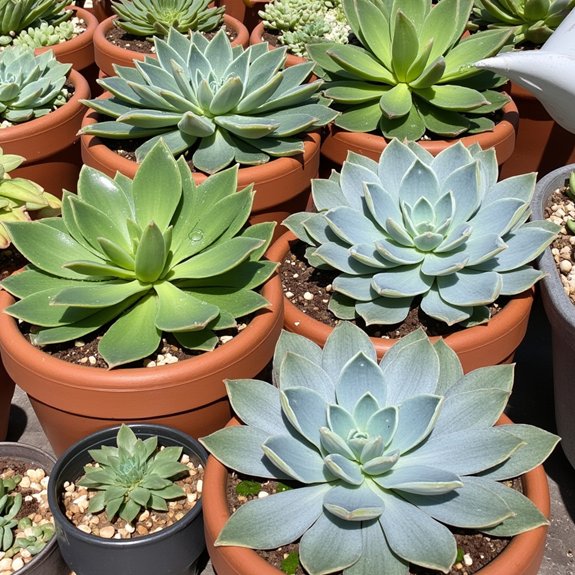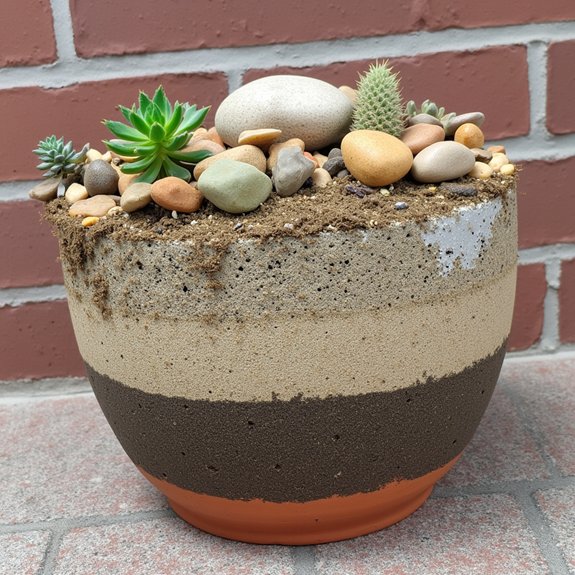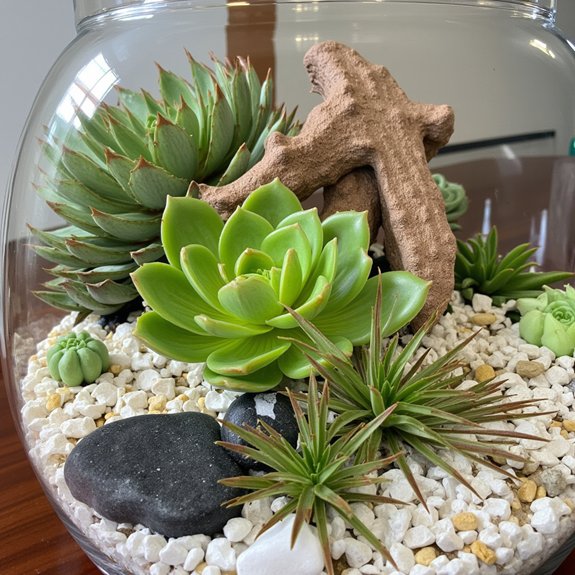Succulents planted directly in decorative rocks create stunning displays, but this popular gardening trend often leads to disappointment within three to four months. These water-storing plants require specific drainage ratios and mineral access that pure rock environments cannot provide. While their thick, fleshy leaves suggest they need minimal care, the reality involves complex root systems that demand balanced moisture retention and nutrient absorption. The question becomes whether aesthetic appeal can coexist with proper plant biology, and the answer might surprise many gardeners.
Contents
Understanding Succulent Water and Nutrient Requirements

Although many gardeners assume succulents need minimal care, these drought-adapted plants have specific water and nutrient requirements that determine their survival. Their thick leaves excel at water storage, holding moisture for weeks between waterings. However, this adaptation doesn’t eliminate their need for proper nutrition.
Succulents require essential macronutrients like nitrogen, phosphorus, and potassium for healthy growth. Without adequate nutrient absorption through their root systems, these plants gradually weaken and die. While they tolerate drought conditions, they cannot manufacture nutrients from thin air, making soil-based growing mediums vital for long-term success.
The Reality of Growing Succulents in Rocks Alone
The harsh truth about rock-only succulent gardens disappoints many enthusiasts who discover their beautiful arrangements failing within months. While succulents appear hardy, their survival depends on consistent moisture and nutrient access that rocks simply cannot provide.
Rock limitations become evident within weeks. These decorative stones drain water rapidly, leaving roots perpetually thirsty. Without nitrogen, phosphorus, and potassium from soil, plants slowly starve despite appearing healthy initially.
Most succulents in pure rock arrangements survive two to four months before showing stress signs. Succulent survival requires the balance rocks cannot deliver alone.
Best Practices for Combining Rocks With Proper Growing Medium

Smart gardeners solve the rock dilemma by creating layered systems that deliver both visual appeal and plant health. The foundation requires well-draining succulent potting mix, providing essential nutrients and moisture retention. Rock layering comes next, using small decorative stones as a top dressing over the soil surface.
Effective drainage techniques involve placing coarse rocks at container bottoms, followed by soil, then finishing with aesthetic pebbles. This three-layer approach prevents waterlogging while maintaining the desired rocky appearance. The underlying soil nourishes roots, while surface rocks create visual interest and help regulate moisture evaporation rates.
Clay Pebbles as an Alternative to Traditional Rocks
When traditional rocks fall short of expectations, expanded clay pebbles emerge as a superior alternative that addresses most succulent growing challenges. These lightweight, porous balls absorb excess water while releasing it slowly, creating ideal moisture regulation for drought-tolerant plants. Clay pebble benefits include reusability, consistent drainage, and reduced maintenance requirements.
Unlike decorative rocks that provide zero nutrition, expanded clay can hold liquid fertilizer when needed. They’re particularly valuable for serial over-waterers, since the pebbles prevent root rot by absorbing only necessary moisture. This makes them perfect for beginners who struggle with traditional watering schedules.
Achieving Aesthetic Appeal While Maintaining Plant Health

Although many gardeners assume they must choose between stunning visual appeal and proper plant care, successful succulent arrangements actually depend on cleverly balancing both priorities. The key lies in strategic layering that conceals soil beneath decorative elements. Start with proper succulent potting mix, then carefully arrange rocks around the plant base, leaving soil visible only near roots. This technique maintains essential drainage while creating impressive rock arrangements that satisfy aesthetic desires.
For terrariums, position coarse rocks at the bottom for drainage, add soil in the middle section, then top with fine decorative stones. Plant aesthetics improve dramatically without compromising health.
